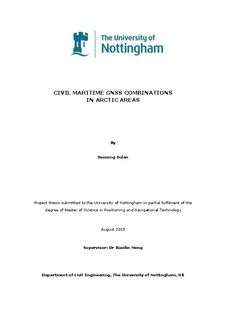| dc.description.abstract | GPS is the most used GNSS system on board civilian vessels using civil GPS signal L1 only. Since 2011, there have been two fully operational GNSS systems – GPS since 1995 and GLONASS since 2011. Both GPS and GLONASS conduct modernization programs involving new satellites, new signals and new ground segment stations. New GNSS equipment is needed to exploit the new signals and both GNSS systems in a combined positioning approach. Future GNSS systems are Galileo and BeiDou.
The Northeast Passage (NEP) is the shipping route between Europe and Asia passing Norwegian and Russian territory. The NEP is about 40% shorter than the voyage through Suez channel. The reduction of sea ice in the arctic area around Svalbard and NEP has increased the use of NEP for civilian vessels. The cold and harsh environment in NEP demands robust and reliable navigation equipment for solving position solutions. The distinctiveness of the Arctic is the latitude. It is higher than the inclination angle to Equator of the GNSS satellites orbital planes and the arctic area has ionospheric irregularities due to Aurora Borealis.
In the thesis, a GNSS measurement was conducted at Svalbard on 16 to 18 June 2015. The aim of the research is to compare the GNSS combinations positioning approach: GPS Single, GLONASS, GPS Dual, GPS+GLONASS combined and DGPS.
The RTKLIB version 2.4.3, an open source GNSS processing software program was used to evaluate the solutions of the GNSS combinations by post-processing the data collected at Svalbard. The research compared the GNSS combinations in a long and short static test, in a dynamic ship moving simulation and during sun activity.
The GPS+GLONASS combination has shown to be more robust in accuracy, precision, availability of all GNSS satellites and their signals during the static and dynamic test in the Arctic. Due to redundancy and robustness, it is advantageous to use the GPS+GLONASS combination for safe navigation in the arctic area around Svalbard and in the Northeast Passage for civilian vessels. | nb_NO |
